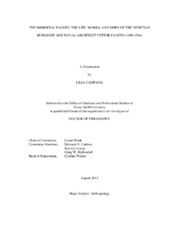| dc.description.abstract | At the beginning of the sixteenth century, the maritime power of the Republic of Venice was seriously threatened by the Ottoman Sultan Suleiman I in the East, and by the Holy Roman Emperor Charles V in the West. In order to regain its naval power in the Mediterranean, the Republic of Venice strongly encouraged Venetian shipwrights to submit new designs for war galleys. The undisputed founder and champion of this naval program was not a skilled shipwright but a young professor of Greek in the School of Saint Mark named Vettor Fausto (1490-1546), who in the heat of this renewal programme, proposed “naval architecture” as a new scientia.
In 1529, Vettor Fausto built a quinqueremis whose design, he claimed, was based upon the quinquereme “used by the Romans during their wars” and that he had derived the shipbuilding proportions “from the most ancient Greek manuscripts.” The recovery of Classical traditions resulted in major changes in many fields. It included shipbuilding practices as well, especially after Fausto introduced in the Venetian Arsenal a new scientia, that of “naval architecture”, in opposition to the fabrilis peritia, the empirical shipbuilding practice.
This study examines several Renaissance sources and archival material in order to illuminate the technical features and the design of Fausto’s quinquereme. Based on the study of the anonymous sixteenth-century Venetian manuscript Misure di vascelli etc. di…proto dell’Arsenale di Venetia from the State Archive of Venice, this dissertation presents a general overview of Fausto’s life and his cultural background in order to better understand the humanistic foundations that led him to propose the construction of the quinquereme. Also presented here is a theoretical reconstruction of Fausto’s quinquereme along with other types of vessels built by Fausto, namely light galleys and great galleys. Furthermore, it will be suggested that the anonymous manuscript Misure di vascelli records the shipbuilding instructions to build the ships that Fausto designed during his tenure in the Arsenal of Venice. | en |


